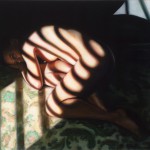Essay Sporthorse 2011
The lustrous beauty of quivering horse flesh; anticipatory, agile, fleet and stacked to the boards with magnificent attitude, there is nothing quite as seductive as a horse.
There is also nothing quite as seductive as the obsession of riding and Keeling is certainly no stranger to this with two magnificent horses now occupying much of her time. That Keeling has chosen to paint horses from the top of their field, those that most typify their breed and trained purpose, whether that be racing, dressage, show jumping or Polo, while testament to the perfection of the animals individual physicality is also indicative of equine husbandry’s perpetual striving for excellence. As such, Keeling has captured the exaggerated musculature of the champion that is equally desired for the ensuing talent and extreme aesthetics of exemplification; the elongation of More Strawberry’s flank where every vessel is primed for speed, as apposed to the crested curves of Zena that posit absolute control and unmistakable intelligence. The addition of specific tack, such as the double bridle and supple leather reins draped across the wither and strong shoulder of Australia’s leading dressage horse Victory Salute, or the sheer elegance of Colthaga’s Mexican grackle, further denotes the ongoing adherence to rigorous specification.
In painting each horse in isolation, Keeling has denied the contextual narration of the equine painting genre. Gone are the bucolic George Stubb’s pastures, the rural grit of Edvard Munch’s galloping steeds or the war and race narratives of Sir Alfred Munnings, rather it is a pared down contemplation of the horse alone, where coat, colour, form, conformational difference of flank and stature, long slim necks and arching manes are the only drivers. In effect each horse is objectified as prime, without the stultifying competition pose of traditional horse portraiture; rather they are captured to define the individual horse’s personality. What makes this particularly interesting is the clarity of attitude the horse presents to the viewer. The result is mesmerising, in that an instant anthropomorphic reading takes place, where the horse’s intent is clear and marked, whether it be nonplussed as Colthaga or as cocky as Yandoo Zenzel. The eyes in particular drive this home with Aber Hallo casting a look that is thoroughly cognisant of the viewer’s adoration. And while adoration is certainly part of the equation, the underlining force of the work is the physicality of the horse as object, refined, statuesque and epitomising excellence.







